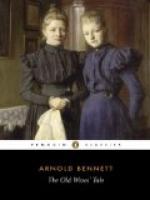CHAPTER I
FRENSHAM’S
I
Matthew Peel-Swynnerton sat in the long dining-room of the Pension Frensham, Rue Lord Byron, Paris; and he looked out of place there. It was an apartment about thirty feet in length, and of the width of two windows, which sufficiently lighted one half of a very long table with round ends. The gloom of the other extremity was illumined by a large mirror in a tarnished gilt frame, which filled a good portion of the wall opposite the windows. Near the mirror was a high folding-screen of four leaves, and behind this screen could be heard the sound of a door continually shutting and opening. In the long wall to the left of the windows were two doors, one dark and important, a door of state, through which a procession of hungry and a procession of sated solemn self-conscious persons passed twice daily, and the other, a smaller door, glazed, its glass painted with wreaths of roses, not an original door of the house, but a late breach in the wall, that seemed to lead to the dangerous and to the naughty. The wall-paper and the window drapery were rich and forbidding, dark in hue, mysterious of pattern. Over the state-door was a pair of antlers. And at intervals, so high up as to defy inspection, engravings and oil-paintings made oblong patches on the walls. They were hung from immense nails with porcelain heads, and they appeared to depict the more majestic aspect of man and nature. One engraving, over the mantelpiece and nearer earth than the rest, unmistakably showed Louis Philippe and his family in attitudes of virtue. Beneath this royal group, a vast gilt clock, flanked by pendants of the same period, gave the right time—a quarter past seven.
And down the room, filling it, ran the great white table, bordered with bowed heads and the backs of chairs. There were over thirty people at the table, and the peculiarly restrained noisiness of their knives and forks on the plates proved that they were a discreet and a correct people. Their clothes—blouses, bodices, and jackets—did not flatter the lust of the eye. Only two or three were in evening dress. They spoke little, and generally in a timorous tone, as though silence had been enjoined. Somebody would half-whisper a remark, and then his neighbour, absently fingering her bread and lifting gaze from her plate into vacancy, would conscientiously weigh the remark and half-whisper in reply: “I dare say.” But a few spoke loudly and volubly, and were regarded by the rest, who envied them, as underbred.




